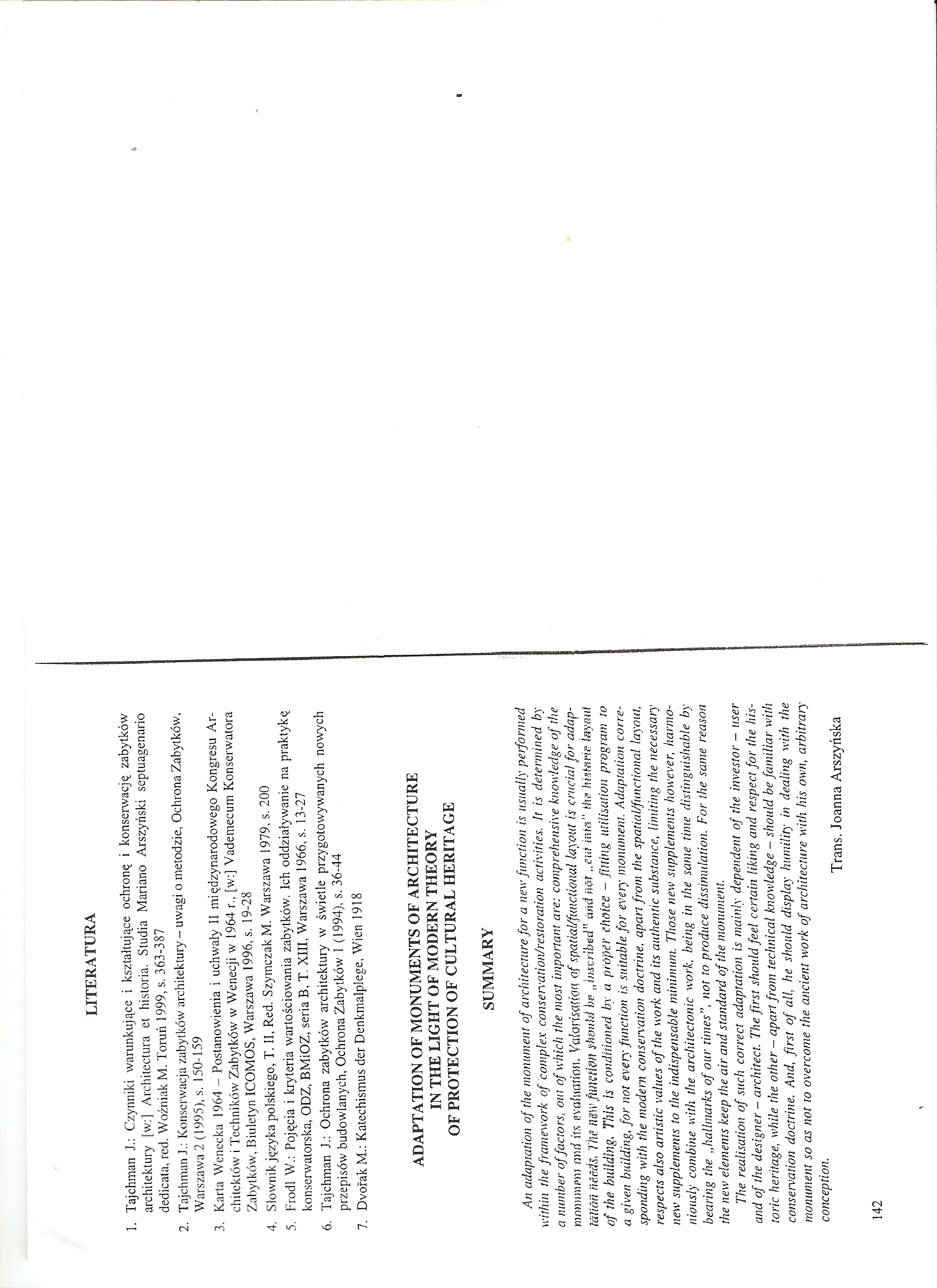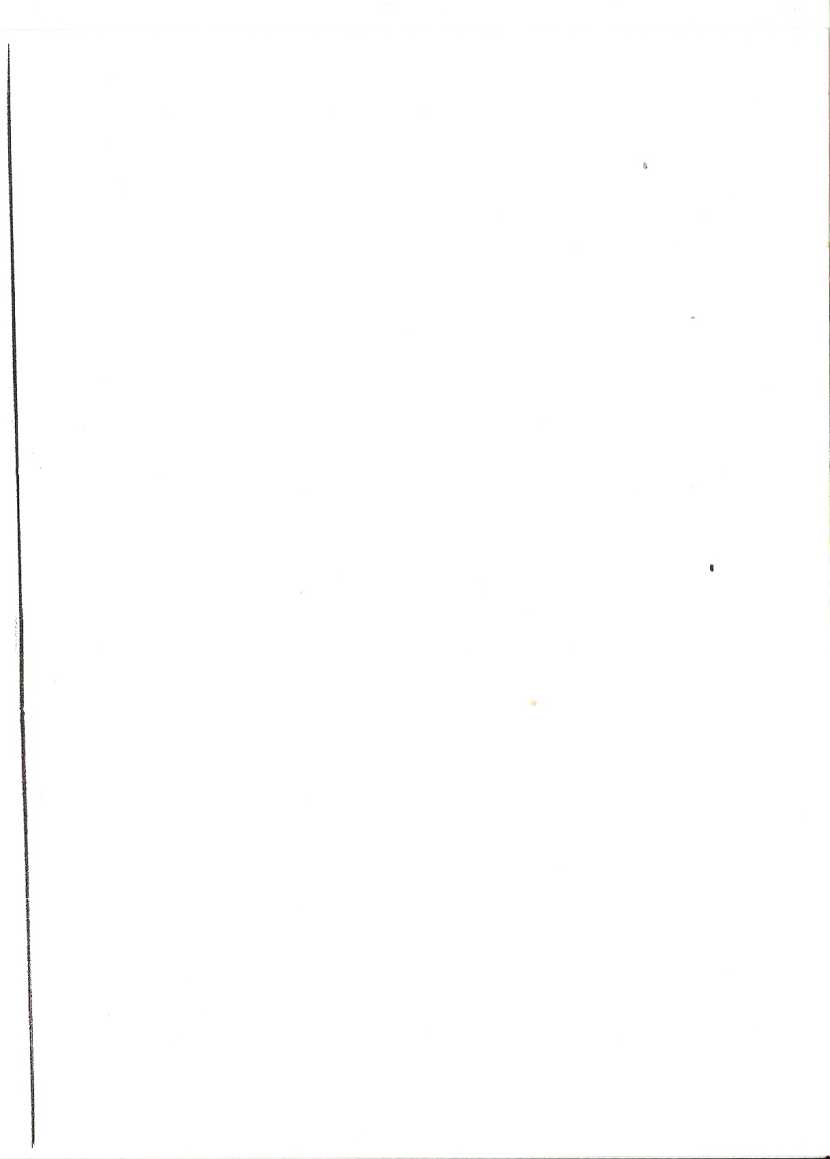59047 skanuj0007 (33)

LITERATURA
1. Tajchman J.: Czynniki warunkujące i kształtujące ochroną i konserwacją zabytków architektury [w:] Architectura et historia. Studia Mariano Arszyński septuagenario dedicata, red. Woźniak M. Toruń 1999, s. 363-387
2. Tajchman J.: Konserwacja zabytków architektury - uwagi o metodzie, Ochrona Zabytków, Warszawa 2 (1995), s. 150-159
3. Karta Wenecka 1964 - Postanowienia i uchwały 11 miądzynarodowego Kongresu Architektów i Techników Zabytków w Wenecji w 1964 r., [w:] Vademecum Konserwatora Zabytków, Biuletyn ICOMOS, Warszawa 1996, s. 19-28
4. Słownik języka polskiego, T. II, Red. Szymczak M. Warszawa 1979, s. 200
5. Frodl W.: Pojęcia i kryteria wartościowania zabytków. Ich oddziaływanie na praktykę konserwatorska, ODZ, BMiOZ, seria B, T. XIII, Warszawa 1966, s. 13-27
6. Tajchman J.: Ochrona zabytków architektury w świetle przygotowywanych nowych przepisów budowlanych, Ochrona Zabytków 1 (1994), s. 36-44
7. Dvorak M.: Katechismus der Denkmalplege, Wien 1918
ADAPTATION OF MONUMENTS OF ARCHITECTURE IN THE LIGHT OF MODERN THEORY OF PROTECTION OF CULTURAL HERITAGE
SUMMARY
An adapiation ofthe monument of architecture for a new function is usually peiformed within the framework of 'complex consen-ation/restoration activities. It is determined by a number of facto rs, out ofwhich the most important are: comprehensive knowledge of the monumpm and its evafuanoti. of spadal/functiomł layout is cnicial foradap-
latióii łieeds. Tlił I18W fiłllSfWn should be „łnscribsd" and fiOT „cut inia” the historie lny aut of the bullding. This Is condiiioned by a proper dwice - fltting utilisarion program to a given building, for not every function is suitable for every monument. Adapiation corre-sponding with the modem consemation doctrine, apart from the spatiaUfunctional layout, respects also artistic values ofthe work and its authentic substance, limiting the necessary new supplements to the indispensable minimum. Those new supplements however, harmo-niously combine with the architectonic work, being in the same time distinguishable by bearing the „hallmarks of our times”, not to produce dissinuilation. For the same reason the new elements keep the air and standard of the monument.
The realisation of such correct adapiation is mainly dependent of the investor — user and ofthe designer — architect. Thefirst shouldfeel certain liking and respect for the historie heritage, while the other — apart from technical knowledge - should be familiar with conservation doctrine. And, first of all, he should display humility in dealing with the monument so as not to overcome the ancient work of architecture with his own, arbitrary conception.
Trans. Joanna Arszyńska

Wyszukiwarka
Podobne podstrony:
43363 skanuj0004 (44) Tab. II Schemat prezentujący czynniki warunkujące i kształtujące adaptacje zab
skanuj0058 (33) Literatura uzupełniająca fraeriwko wycince lasów pod budowę autostrad. Zorganizowana
skanuj0073 (14) 814.5. Podaż i czynniki ją kształtujące Podaż w ujęciu teoretycznym jest to relacj
skanuj0012 (22) 17LJ Ato czym polega metodo ochrony, konserwacji i zagospodarowania ruin zamkowych I
28156 skanuj0012 (22) 17LJ Ato czym polega metodo ochrony, konserwacji i zagospodarowania ruin zamko
skanuj0012 (22) 17LJ Ato czym polega metodo ochrony, konserwacji i zagospodarowania ruin zamkowych I
28156 skanuj0012 (22) 17LJ Ato czym polega metodo ochrony, konserwacji i zagospodarowania ruin zamko
skanuj0083 (33) Gdy wymiary połączenia oraz jego obciążenie wynikają z warunków konstrukcyjno-wytrzy
skanuj0011 5 Joanna Sadkowska-Bt&ń istotna zależność pomiędzy czynnikami warunkującymi proces wd
więcej podobnych podstron